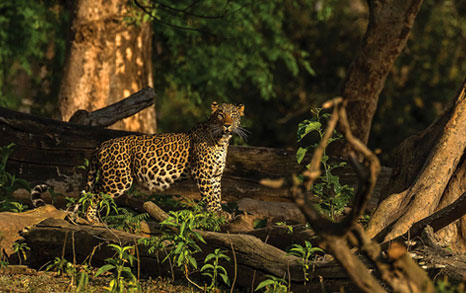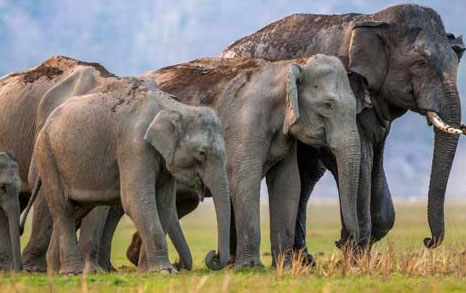Rajaji National Park Fauna
Rajaji National Park stands as a proud spot due to its thriving elephant population. Situated amidst the Himalayan foothills near Haridwar, Rishikesh, and Dehradun, with the majestic Ganga and Son rivers meandering through its terrain, the park is renowned for its picturesque landscapes and rich biodiversity. Serving as a sanctuary for both nature lovers and wildlife enthusiasts, Rajaji National Park shelters a wide variety of animals, ranging from elephants, tigers, and leopards to deer, gorals, and an abundance of bird species.
Established in 1983, Rajaji National Park in Uttarakhand is the amalgamation of three sanctuaries: Rajaji, Motichur, and Chilla. This vast protected area pays homage to the revered freedom fighter and India's first Governor-General, C. Rajagopalachari, fondly remembered as "Rajaji.”


Located at the confluence of the lower Himalayan foothills and the expansive Indo-Gangetic plains, Rajaji National Park provides a captivating ecosystem for its varied wildlife, featuring a notable concentration of elephants and leopards. Acting as the northwest boundary for Bengal Tigers and Asian Elephants in India, the park covers an extensive area of 820 sq. km, incorporating Rajaji, Motichur, and Chilla wildlife sanctuaries, along with segments of Dehradun, Shiwalik, and Lansdowne Forest Divisions.
Traversed by the sacred River Ganges and several streams, the terrain of the park is teeming with richness and variety. This vast landscape offers nature enthusiasts abundant chances to appreciate the stunning vistas and witness the flourishing wildlife in its native surroundings. Rajaji National Park serves as a living example of the harmonious blend of urban development and untouched wilderness, beckoning those in search of solace amidst the grandeur of nature.
Fauna Species of Rajaji
Rajaji National Park is home to a rich variety of wildlife, encompassing species like Cheetal, Barking Deer, Sambar Deer, Wild Boar, Nilgai, Goral, and the revered Asian Elephant, which is the focal point of conservation efforts under Project Elephant. Additionally, the park hosts primates like the Rhesus Macaque and Hanuman Langur, while smaller mammals such as the Indian Hare and Indian Porcupine further enhance its mammalian diversity.
Rajaji National Park is home to a diverse array of reptiles, including notable species such as the Python, King Cobra, Common Krait, Indian Cobra, and Monitor Lizard.
Rajaji National Park boasts a vibrant avian community, with approximately 315 species of birds thriving within its boundaries. Among them, India's National bird, the Peacock, graces the landscape alongside a variety of butterflies and smaller birds such as the Rusty-cheeked Scimitar, Golden-spectacled Warbler, Chestnut-tailed Starling, Drongo Cuckoo, Brown Hawk-Owl, Slaty-headed Parakeets, Great Hornbill, Red Jungle Fowl, Lineated Barbet, Black Hooded Oriole, Crested Kingfishers, Khaleej Pheasant, Finches, Woodpeckers, Oriental Pied Hornbill, Thrushes and Crimson Sunbird. Notably, Rajaji serves as the initial staging ground for migratory birds upon their crossing of the formidable Himalayas into the Indian subcontinent.
The Ganga and Son Rivers, coursing through the park, nurture a diverse aquatic ecosystem teeming with life, including Goonch, Trout, Kalabasu, Mahseer, and Chilwa, alongside crabs and small fishes inhabiting the streams that feed into these mighty rivers. Rajaji National Park's flourishing ecosystems exemplify the harmonious coexistence of diverse species, weaving a vibrant tapestry of biodiversity awaiting exploration and appreciation by nature enthusiasts.